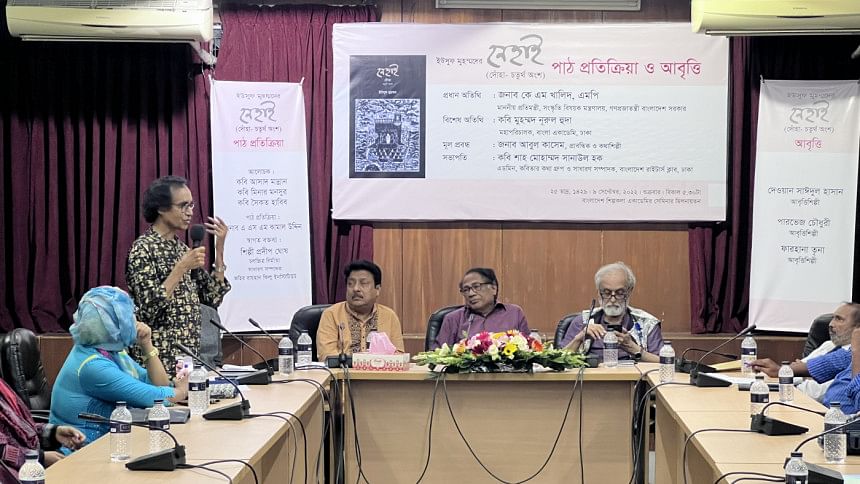In ‘Nehai’, Yusuf Muhammad’s doha verses explore the ceaselessness of life

The word 'doha' descended from the Brajabuli language, literally meaning 'two' or 'both'. It is a special kind of poetry written in couplets. The connotative meaning of this word signifies creation from the union of two entities: man and woman, Adam and Hawa, Jivatma and Paramatma. Its origin dates back almost 1,400 years from today, composed by Soroho-Pa. These were composed in the Sandhya language—a combination of Apabhramsa and other ancient forms of Indo-Aryan languages with obscure meanings, used by religious cults and saints.
On the evening of September 9, poet Yusuf Muhammad held a recitation and discussion session over Nehai (Agami Publishers, 2022), his fourth collection of doha poetry, at the Seminar Hall of Bangladesh Shilpakala Academy.
The event was jointly organised by the Zahir Raihan Film Institute and the Kobitar Kotha group. The program was attended by KM Khalid, honourable State Minister for Cultural Affairs, People's Republic of Bangladesh, and poet Nurul Huda, Director General of Bangla Academy.
Poet Shah Md Sanaul Hoque presided over the event. Other notable speakers included poets Asad Mannan, Minar Mansur, and Saikat Habib, and ASM Kamaluddin. Dewan Saidul Hasan, Parvez Chowdhury and Farhana Trina recited poetry from Yusuf Muhammad's collection. The welcome speech was delivered by noted Bangladeshi filmmaker, Pradip Ghosh.
The Bengali Medieval era, particularly between the 15th and 16th-centuries, was the golden age of dohas. It was during this time that the famous dohakar Kabir Das composed many couplets which were orally transmitted in different parts of India. Much later, in 1915, Rabindranath Tagore translated 100 of Kabir Das's dohas to English. The aim of a dohakar has always been to open the eyes of the masses, to introduce a different perspective. In fact, many of the dohas written by the two prominent dohakars, Soroho-Pa and Kabir Das, have modernist, anti-establishment themes, criticising the social, political and religious conventions of their times.
At the discussion session, prominent essayist and writer Abul Kashem read out "Yusuf Muhammad, the poet of Doha", an essay about the history and evolution of the Indian subcontinent's doha and dohakars and the works of Yusuf Muhammad, a 21st century dohakar himself.
Yusuf Muhammad was born on November 27 in Fatehabad, Chittagong. He has been writing dohas for 20 years and has composed 453 dohas till date.
His work is deeply influenced by the dohas of the 15th-century Indian mystic and poet, Kabir Das. Having also studied the dohas of Soroho-Pa, Kanho-Pa, Mirabai, Rahim, Tulsidas and Surdas broadly, Muhammad retains in his work both the original tradition of the ancient and medieval dohas and recreates dohas for modern readers.
Nehai, the title of his latest collection and literally meaning 'anvil', likens the life of a human being to that of an anvil used by the blacksmith. The blacksmith hammers hot iron on an anvil to change its shape. The piece is then replaced by another hot piece of iron, which again will be hammered over the anvil. The cycle repeats.
All along the process, the anvil remains there, unmoving, while the iron pieces take shape under the blacksmith's hammer. Human life is similarly shaped by pleasant and unpleasant experiences. Like the fixed anvil, human beings are affixed by life; there is no running away from the events and cycles of life till death takes one away.
"A hundred years after Rabindranath, Bangla poetry saw the arrival of the panchakabis, Jibanananda Das among them", Minar Mansur said at the event. "We have to try to write even better than them. Yusuf Muhammad's doha is an experimental work. He has been working with the form for a long time. May his experiment be successful."
Nehai is available on Rokomari.

 For all latest news, follow The Daily Star's Google News channel.
For all latest news, follow The Daily Star's Google News channel. 









Comments